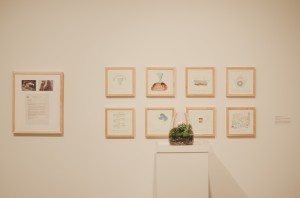When it comes to value, one might think that an artist, a public policy specialist, an economist and a philosopher would be hard-pressed to find common ground.
Yet on Wednesday, March 20 at 4 p.m. in the Arts and Interactive Multimedia Building, that exact mix of interdisciplinary experts came together to contemplate the concept of value in art, business and life.
Dean William Keep of the School of Business, along with Richard Kamber, professor of philosophy and Randall Solomon, co-director of the Sustainability Institute at the College held a panel discussion with guest curator and adjunct art professor, Betsy Alwin.
“It’s the arts that are the glue, the binding forces that draw us together,” said John C. Laughton, dean of the College’s Arts and Communication School in his opening speech, “Art is about the ideas, and in the end you take those ideas and you do something with them.”
Among this diverse panel’s exchange of ideas, value was the point of harmony.
Keep, having a background in economics, played with the idea that “markets tend to be good at identifying individuals’ interests” and at monetizing products and services based on those values.
However, he noted that the art world is completely unusual in this regard.
“Different people are willing to pay different prices for art,” Keep said, explaining that this would make it difficult for an artist to accurately value their work.
In order to sell, an artist must make a greater effort to please individual buyers, as broader economic forces cannot explain changing artistic needs.
Though, Alwin, speaking for free-spirited creators, found difficulty in this.
Though, Alwin, speaking for free-spirited creators, found difficulty in this.
While she sympathized with artists in an economic crisis, she highlighted the importance of experiencing art and sharing it with an audience.
“The ability to view the work is what we own,” Alwin said, herself a found-object sculptor. “We may pay to go to a museum, but that’s only a nominal amount,” she explained.
Instead, Alwin’s interpretation of value is emotional, physical, spiritual—anything but economic.
Instead, Alwin’s interpretation of value is emotional, physical, spiritual—anything but economic.
Eventually Keep conceded to Alwin’s plea. He realized that students are forgetting about themselves in the midst of hectic job and career preparations.
“Some students now are not being trained to express themselves in a non-monetary way,” Keep said. He even pointed to his own failure in that respect: “I’m 60 years old and I’ve never taken an art class, and I think that’s a shame.”
Kamber then directed the conversation toward the foremost practice of philosophy: confronting social norms.
“Philosophers ask questions that come naturally to children with the skills that come naturally to lawyers,” Kamber said, explaining that good art does the same.
In other words, an artist should aim to “shake people up” and propose questions that challenge the way they perceive reality. Artwork that confronts bias reaches far beyond a single viewer.
In other words, an artist should aim to “shake people up” and propose questions that challenge the way they perceive reality. Artwork that confronts bias reaches far beyond a single viewer.
Not only this, but art also bridges the gap between different disciplines, as was apparent from Wednesday’s assorted panel guests.
“Art’s power is that it exists by itself,” Alwin said, “but it can also speak to other subjects.”
“Art’s power is that it exists by itself,” Alwin said, “but it can also speak to other subjects.”
What Alwin’s perspective suggests for both artists and casual viewers of art is to become enveloped in the experience: to live with art is to cherish life and the diversity of ideas.
Wednesday’s panel discussion took place directly before the opening of Alwin’s new exhibition “Value Added: Artists’ Perspectives on the Meanings of Worth” in the College’s Art Gallery in the AIMM building.







